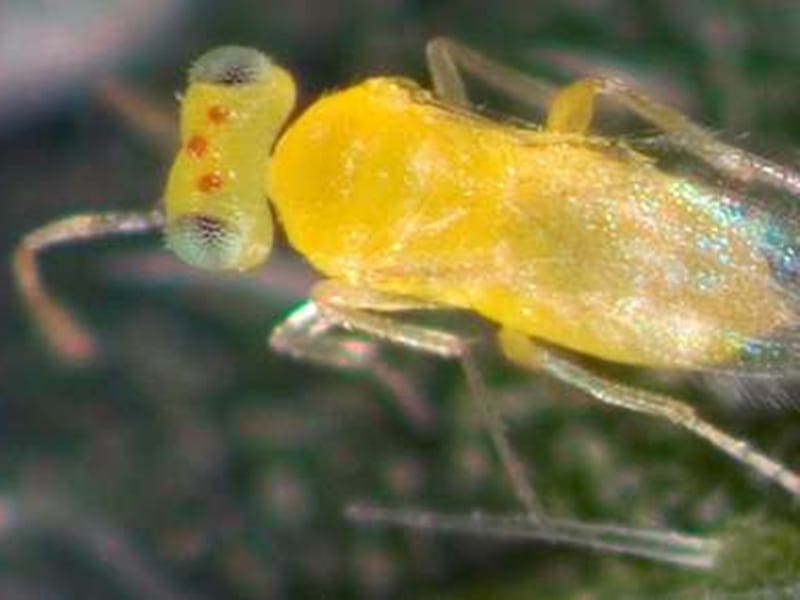Description
Download our Hayati tech sheet
Target pest
- Silverleaf whitefly (Bemisia tabaci)
Advantages
- Excellent searching ability
- Efficient biocontrol even at low host densities
- Both adult and immature wasps attack whiteflies
- Adult wasps kill whitefly nymphs by feeding on them
- Wasp larvae develop as parasitoids within whitefly nymphs, eventually killing them
Suitable crop environments
- Successfully used within an IPM program in outdoor vegetable production, cotton and greenhouse vegetables
- Beneficial insects, especially tiny wasps, prefer a protected environment – Hayati are most effective in a crop that has good foliage development, is well irrigated and free from pesticide residues and dust
- Note that biosecurity restrictions prevent us from sending this product to Tasmania at this stage.
Release rates
Release rates vary depending on the crop and level of infestation. The following recommendations are provided as a guide:
- Field crops – 5,000 wasps/ha per release. Make 5 releases at intervals of 2-3 weeks. Further releases may be required following adverse conditions or during periods of intense whitefly activity.
- Greenhouses – 5 wasps/m2 per release. Begin weekly releases before or at the first sign of whitefly activity. Continue until control is achieved or parasitism reaches 80%. If whitefly is already active in the crop higher release rates may be required.
Unlike chemicals, when it comes to beneficials, more is always better. However, they are costly to produce and our goal is to achieve the best results at minimal expense. Factors to consider include the value of the crop, the severity of the pest outbreak and the activity (or otherwise) of naturally occurring beneficial species.
Multiple releases of modest numbers is better than a single large release. This reduces risk, improves establishment and accelerates the development of multiple overlapping generations. Hayati releases are inoculative and we anticipate that they will establish and breed up within the crop to give extended protection.
Pack size, storage and handling
- Supplied in small plastic vials with a cotton plug insert
- Each vial contains 500 wasp pupae
- Sold in packs of 10 vials (total 5,000 wasps per pack)
- Wasps begin to emerge in transit or shortly after arrival
- If adult wasps are not yet visible in the vials, store at room temperature (out of direct sunlight) until the first wasps emerge
- Release as soon as possible after adult wasp activity is detected – storage of adult wasps is not recommended, but if immediate release is not possible they may be stored for up to 2 days at 8-12°C
When to release
- Release before or at the first sign of whitefly activity
- Preventative release into neighbouring vegetation where whiteflies are present can help establish the beneficial population early in the life of the crop
How to release
- Before release, check prior history of chemical use to ensure toxic residues are no longer present
- Place vials uniformly throughout the crop
- Hang vial cap over a leaf petiole, tie wire or similar
- Remove cotton plug to allow wasps to emerge
- Dedicated beneficial insect release drones can greatly speed up the release process for area wide treatment
Monitoring after release
- It is not easy to find adult wasps after release
- With experience it is possible to assess the level of parasitism by examining whitefly nymphs and empty whitefly pupal cases with a hand lens or microscope
- The CottonInfo video below describes how to do this
Cultural practices to aid establishment
- Watch for ant activity as aggressive ant populations can interfere with wasp establishment – ants may need to be controlled if this is the case
Complementary biocontrol
- Montdorensis predatory mites
Chemical use
Hayati are very effective biocontrol agents but they are sensitive to many pesticides. Harmful pesticides may be directly toxic or have sublethal effects, preventing Hayati from establishing and/or reducing their efficacy. Some insecticides (e.g. synthetic pyrethroids, organophosphates and neonicotinoids) can have residual toxicity that affects Hayati for many weeks.
If pesticides are required, always check for side-effects and select products that are least harmful to Eretmocerus hayati and other key beneficials in your IPM program. As a guide, consult the Biobest Side Effects App for information about the effects of pesticides on Eretmocerus spp. and other biocontrol agents.
















Reviews
There are no reviews yet.